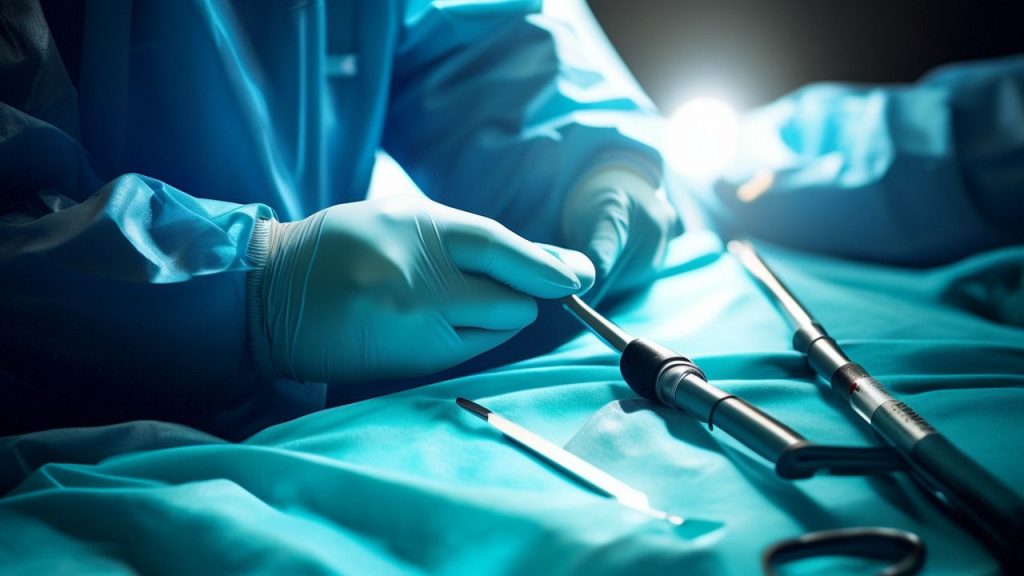Detailed step-by-step process of eyelid surgery
Eyelid surgery is a cosmetic procedure that aims to improve the appearance of the eyelids. Here is a detailed step-by-step process of the surgery:

- Preoperative Consultation: The surgeon evaluates the patient’s medical history, discusses the desired outcomes, and determines the best approach for the surgery.
- Preparation: The patient is prepped for surgery. This includes marking the areas to be treated, administering anesthesia (local or general, depending on the case), and sterilizing the surgical site.
- Incision: The surgeon makes incisions along the natural creases of the eyelids (for upper lids) or just below the eyelashes or inside the lower lid (for lower lids).
- Removal or Redistribution of Fat: Excess fat that causes puffiness is either removed or redistributed.
- Removal of Excess Skin: The surgeon trims away any excess skin that is causing droopiness or obstructing vision.
- Muscle Adjustment: In some cases, the muscle may also be tightened.
- Closure: The incisions are closed using sutures.
- Postoperative Care: The patient is given instructions on how to care for the eyes post-surgery, which may include using ice packs, eye drops, and avoiding certain activities.
- Follow-up: The surgeon schedules follow-up appointments to monitor the healing process and remove sutures if necessary.
This procedure helps to create a more youthful and refreshed appearance by reducing bagginess and sagging of the eyelids.
Suitable Candidates for Eyelid Surgery:
- Aging Eyes: Individuals with excess skin on the upper eyelids that may be impairing vision or causing a tired appearance.
- Puffy or Baggy Eyes: People with bags under their eyes or puffiness in the eyelids due to excess fat.
- Sagging Eyelids: Those with lower eyelids that sag and expose the white below the iris.
- Good Health: Candidates should be in good overall health, without any serious eye conditions or diseases that could impair healing.
- Realistic Expectations: Individuals who understand the procedure and have realistic expectations about the outcome.
- Non-Smokers: Smoking can affect the healing process, so non-smokers or those willing to quit temporarily are ideal.

Unsuitable Candidates for Eyelid Surgery:
- Eye Conditions: Individuals with certain eye conditions such as glaucoma, dry eye, or detached retina may not be suitable candidates.
- Thyroid Disorders: People with thyroid disorders like Grave’s disease, which can cause protruding eyes, may not benefit from this surgery.
- High Blood Pressure or Cardiovascular Disease: These conditions can increase the risk of complications during surgery.
- Diabetes: Diabetes can affect the healing process and increase the risk of infection.
- Lack of Skin Elasticity: If the skin around the eyes lacks elasticity, the results may not be as effective.
- Recent Facial Surgery or Trauma: Candidates should not have had recent facial surgery or trauma that could affect the outcome of the procedure.
- Unrealistic Expectations: Individuals who expect the surgery to completely alter their appearance or solve personal issues may not be suitable.
- Pregnant or Nursing: Pregnant or nursing women should postpone the surgery until after they have stopped nursing and their hormones have stabilized.
Surgical methods
Eyelid surgery, or blepharoplasty, can be performed using several different techniques, depending on the specific needs and goals of the patient. Here are the main surgical methods:
- Upper Blepharoplasty: This procedure focuses on the upper eyelids. The surgeon makes an incision along the natural crease of the upper eyelid to remove excess skin and fat, and sometimes tighten the muscles. This method is commonly used to address hooded or droopy eyelids.
- Lower Blepharoplasty: This technique targets the lower eyelids. Incisions can be made just below the lower lash line or inside the lower lid (transconjunctival approach). Through these incisions, the surgeon removes or redistributes excess fat and sometimes trims sagging skin and tightens muscles. This method is often used to eliminate bags under the eyes and reduce puffiness.
- Transconjunctival Blepharoplasty: This is a specific type of lower blepharoplasty where the incision is made inside the lower eyelid, leaving no visible scar. It is primarily used to remove or reposition fat, but not for removing excess skin. This method is ideal for younger patients with good skin elasticity.
- Asian Eyelid Surgery (Double Eyelid Surgery): This is a specialized form of blepharoplasty that creates a crease in the upper eyelid for individuals of Asian descent who naturally have a single eyelid fold. The incision is made along the desired fold line, and excess skin and fat are removed or repositioned.
- Ptosis Repair: Sometimes combined with upper blepharoplasty, ptosis repair specifically addresses a drooping eyelid by tightening the muscle that lifts the eyelid. This can be done through the same incision used for upper blepharoplasty.
- Laser Blepharoplasty: This method uses a laser to make the incisions, which can help with precision and may promote faster healing due to the laser’s ability to seal blood vessels as it cuts, reducing bleeding and swelling.
- Endoscopic Eyelid Surgery: This is a less common technique that uses an endoscope (a small camera) to assist in the surgery, allowing for smaller incisions and potentially less scarring.
Each of these methods has its own benefits and is chosen based on the patient’s anatomy, the specific issues to be addressed, and the surgeon’s expertise. It’s important for patients to discuss their options with their surgeon to determine the best approach for their individual needs.
How to care for your eyes following blepharoplasty?
Postoperative care after eyelid surgery is crucial to ensure proper healing and achieve the best possible results. Here is a detailed guide on how to care for your eyes following blepharoplasty:
- Rest: Get plenty of rest and avoid strenuous activities for at least a week after surgery. Elevating your head with pillows while sleeping can help reduce swelling.
- Cold Compresses: Apply cold compresses to your eyes for the first 48 hours to minimize swelling and discomfort. Use a clean, soft cloth soaked in ice water, and apply gently.
- Medications: Take any prescribed medications as directed, which may include antibiotics to prevent infection and pain relievers to manage discomfort.
- Eye Lubrication: Use artificial tears or lubricating eye drops as recommended by your surgeon to keep your eyes moist, especially if they feel dry or gritty.
- Avoid Rubbing: Do not rub your eyes, as this can disrupt the healing process and potentially cause complications.
- Suture Care: Keep the sutures clean and dry. Your surgeon will provide instructions on when and how to clean the area around the sutures.
- Sun Protection: Wear sunglasses with UV protection when outdoors to shield your eyes from the sun and wind.
- Follow-Up Appointments: Attend all scheduled follow-up appointments with your surgeon to monitor your healing process and remove sutures if necessary.
- Diet and Hydration: Maintain a healthy diet and stay hydrated to support the healing process.
- Avoid Smoking and Alcohol: Refrain from smoking and consuming alcohol, as these can interfere with healing and increase the risk of complications.
- Avoid Makeup: Do not apply makeup to the eyes until your surgeon gives you the go-ahead, usually after the sutures are removed and the incisions have healed.
- Exercise Caution: Avoid activities that could increase blood flow to the eyes, such as bending over, lifting heavy objects, or engaging in vigorous exercise, until cleared by your surgeon.
- Monitor for Complications: Watch for signs of complications such as excessive bleeding, severe pain, or changes in vision, and contact your surgeon immediately if you experience any concerning symptoms.
Remember, each patient’s recovery is unique, and your surgeon will provide personalized postoperative care instructions tailored to your specific situation. It’s important to follow these instructions closely to ensure a smooth and successful recovery.

The US market
Eyelid surgery is a popular cosmetic procedure in the United States. The market for this surgery is growing due to several factors, including the increasing demand for aesthetic enhancements, the prevalence of certain eye-related conditions, and an aging population. The American Society of Plastic Surgeons reported that approximately 1.5 million cosmetic eyelid procedures were carried out in the U.S. in 2021, indicating a significant market size.
The global eyelid surgery market size was valued at USD 3.98 billion in 2022 and is expected to reach USD 7.39 billion by 2032, with a rapid revenue CAGR of 7.1% during the forecast period. This growth is driven by the rising use of electronic gadgets leading to more dry eyes, the need for non-invasive and risk-free procedures, and the increasing awareness of the benefits of eyelid surgery such as improved vision and enhanced appearance.
Technological advancements in surgical tools and methods, such as laser technology and minimally invasive techniques, are contributing to the growth of the market. Moreover, the market is segmented into upper eyelid surgery, lower eyelid surgery, and combined eyelid surgery, with upper eyelid surgery being a significant contributor to the market’s revenue in 2022.
The demand for eyelid surgery is also supported by the availability of safe and efficient surgical methods and the rising preference for natural-looking results. Ambulatory surgery centers are expected to see the fastest growth in revenue due to their lower costs and quicker recovery times compared to hospitals.
The eyelid surgery market in the United States is substantial and continues to grow, driven by technological advancements, increased awareness, and a preference for minimally invasive procedures.
How to find a suitable surgery institution?
Here are five notable providers of eyelid surgery in the United States:
- American Society of Plastic Surgeons (ASPS): ASPS members are board-certified plastic surgeons who meet rigorous standards, including certification by the American Board of Plastic Surgery (ABPS). They often perform eyelid surgery and are a reliable choice for patients seeking this procedure.
- Johns Hopkins Medicine: The oculofacial plastic surgeons at the Johns Hopkins Wilmer Eye Institute are specialists in cosmetic and reconstructive procedures for the eyelids and face, focusing on both appearance and function.
- Dr. Jose Rodríguez-Feliz: A board-certified plastic surgeon in Miami, Florida, Dr. Rodríguez-Feliz specializes in eyelid surgery, offering both upper and lower blepharoplasty, as well as combined procedures with facelifts or brow lifts.
- RealSelf: While not a medical institution, RealSelf is a platform where patients can find top-rated oculoplastic surgeons, including those who are board-certified and have excellent reviews for their work in eyelid surgery.
- Grand View Research: Although primarily a market research publisher, Grand View Research provides reports that include information about key players in the eyelid surgery market, which can be a resource for identifying leading providers.
Please note that the selection of a provider should be based on individual research, consultation, and personal preferences, ensuring that the chosen provider meets the patient’s specific needs and expectations.